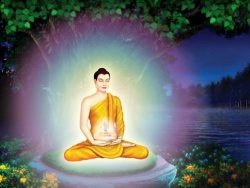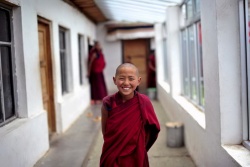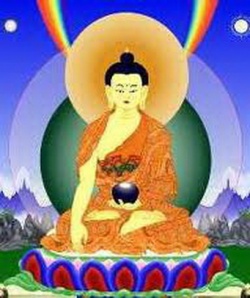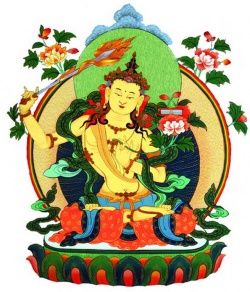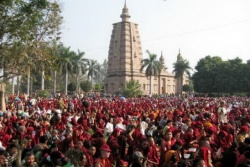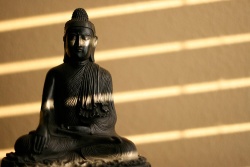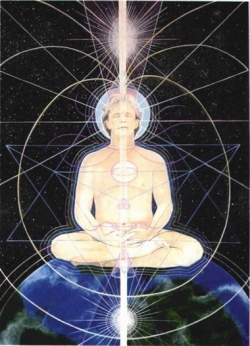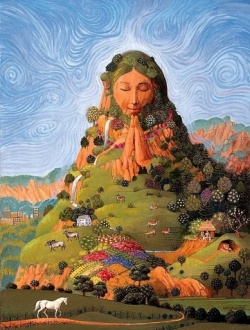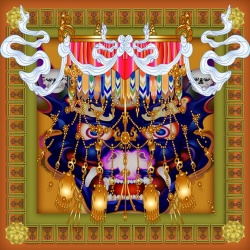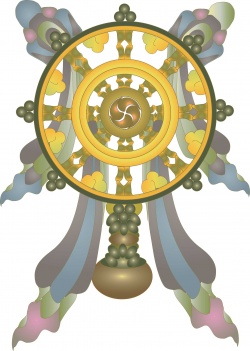Tian Tai Under the Song dynasty (960–1279)
Tian Tai Under the Song dynasty (960–1279)
Questions:
Discuss the controversy between “the Mountain masters” (orthodox) and “Off- mountain masters” (heterodox) during the Song Dynasty.
Explain the salient features of the Tian Tai School in Song Dynasty
Zhanran and the buddha-nature of insentient beings
(Tian Tai nine patriarchs: Nāgārjuna, Huiwen, Huisi, Zhiyi, Guanding, Zhiwei, Xuanlang, Zhanran, Zhili)
The Tiantai school fell into decline in the Tang dynasty (618–907), losing its imperial patronage and dominant influence to the newly arisen Huayan School and Chan School.
Zhanran (711–782) is credited with revitalizing the tradition, meeting the challenges of the new schools and consolidating and reorganizing Tiantai doctrine.
The bulk of his writings concentrate on detailed commentaries to Zhiyi’s works, but he is also responsible for adopting and adapting Huayan terminology into Tiantai doctrine while reasserting the distinctiveness of the Tiantai school, particularly noting the uniqueness of its doctrine of the evil inherent in the buddha-nature.
In his work Jin gang bei (Diamond Scalpel), Zhanran makes a frontal attack on the Huayan and early Chan doctrine that views the buddha-nature as an aspect of sentience, reasserting the Tiantai view that the buddha-nature is necessarily threefold from beginning to end, omnipresent in all three aspects, and impossible to restrict to sentient beings only.
In fact, the threefold buddha-nature is another name for the three truths, which are the reality of any content of experience whatsoever, mind or matter, sentient or insentient
To be any one among them is to be all of them, so there can be no division of buddha-nature as the unconditioned essence of sentience and awareness as opposed to the passive inertness of insentient beings. Whenever one being attains buddhahood, all beings are buddha; whenever one entity is insentient, all beings are insentient. This is the interpervasion of all realms as understood in a Tiantai perspective.
Zhanran had imported certain formulations from Huayan thought into his teaching, most notably an interpretation of mind only doctrine not found in Zhiyi, including the phrase “unchanging but following conditions, following conditions but unchanging,” as a characterization of the mind and its nature, respectively, as derived from the Huayan patriarch Fazang (643–712).
Tiantai Masters in Song Dynasty
After the Tang dynasty, China fell into disunion again before the establishment of Song. The Chinese historians name this short period (907-960) as the five dynasties and ten kingdoms.
After the great persecution of Buddhism in Tang dynasty (845), all the schools with an emphasis of scriptural study disappeared since their texts were burnt and lost. The schools with an emphasis of practice such as Chan and Pure Land survived since these two did not depend so much on scriptures.
During the period of five dynasties, King of Wuyue 吳越 sent envoys to find Buddhist scripture and a Korean monk named Diguan 諦觀 came to China (around 961) and brought many scriptures from Korea, and mostly were Tiantai texts. Thus, Tiantai revived in Song time.
There appeared many teachers of Tiantai school in Song, the following are some important and influential ones.
- 1. Yitong 義通 (927-988) was originally from Korean king’s family. After learning Tiantai teaching from a Chinese master named Yiji 義寂, he started to spread the Tiantai teaching. Later he got two great disciples: Zhili 知禮 and Zunshi 遵式 who revived the Tiantai teaching in Song dynasty.
- 2. Zhili 知 禮 (960-1028) was originally from Siming 四明 in Zhejiang province and studied Tiantai teaching from Yitong 義通 and later he was conferred the title of Grand Master of Dharma Wisdom 法智大師 by the emperor. In his old age, Zhili held Lotus Repentance 法華懺 together with another ten monks and after three years they prepared to be burnt but were persuaded not to do so by people so his name reached far and wide. He was an important figure for the revival of Tiantai school.
- 3. Zunshi 遵式 (964-1032) was originally from Tiantai district and learnt Vinaya first but later studied Tiantai teaching under the same Korean teacher Yitong. Emperor Zhengzong 真 宗 conferred him the title of “Grand Master of the Compassionate Cloud” 慈雲大師. Although Zunshi got the support of some well known people but his lineage was not influential as Zhili.
Both Zhili 知 禮 and Zunshi 遵 式 emphasized repentance 懺 法 specially Lotus Repentance 法華懺 (based on the Lotus Sutra) and Golden light Repentance 金光明懺 (based on the Suvarṇaprabhāsa Sūtra). Zunshi wrote several works on the method of Repentance Ceremony, thus he was named as the “Ciyun Lord of Repentance” 慈 雲懺主.
Home-mountain and Off-mountain
At the end of Tang dynasty, Tian Tai’s literature were lost. Later Tian Tai’s literature were restored from Korea. This initiated a series of broad-reaching debates over the different interpretation of Zhiyi’s doctrine and practice. These debates referred to in Tian Tai sectarian literature as the “home-mountain” (shan-jia) and “off-mountain” (shan-wai) controversies. It repeatedly polarized the Tian Tai community for the next 300 years (Song dynasty, 960-1279).
- Zhili (知礼 960-1028) represents as the Home-mountain,
- Wu-en (晤恩 912-986), Yuan Qing (源清 996), Qing Zhao (庆昭 963-1017), Zhi Yuan (智圆 976-1022). Influenced by Hua Yan School, belong to Off-mountain.
The debate of outsider and insider of Tiantai School is an important event in Tiantai School as well as in the Song dynasty.
The debate started from Wuen’s Commentary on Zhiyi’s Profound Meaning of Suvarṇaprabhāsa 《金光明玄義》. Although the debate is about the authenticity of the Profound Meaning of Suvarṇaprabhāsa, whether it is written by Zhiyi or not, but the actual contents are on the real mind 真心 and defiled mind 妄心.
Thus, the debate concerns with many problems about Buddhist world view as well as practice.
The party led by Zhili 知禮 who stayed in Mount Tiantai won the debate and called them the ‘insider’, the orthodox of Tiantai. The opposition party who stayed outside of the Tiantai mountain and led by Wuen was called ‘outsider’ by the first group and was accused as not orthodox.
There are two versions of Zhiyi’s Profound Meaning of Suvarṇaprabhāsa, one small and one large. Wuen was the opinion that the large version was not Zhiyi’s work since its explanation of the “observation of pure mind” 觀心釋 was not in accordance with his theory.
However, Zhili argued that the large version was Zhiyi’s work and further explained the text and advocated “observation of the defiled mind” 妄心觀.
Zhiyuan 智圓 (976-1022) again wrote a commentary on the same text of Zhiyi and accused the large version as not authentic. Zhili again wrote another essay and argued in favour of the large version.
At last, Zhili emphasized that the central teachings of Tiantai are “the nature of inherited evil” and “three thousand realms within a single mind”. This is the perfect teaching. While the Huayan teaching of dependent arising of dharmadhātu is a special teaching only. Here Zhili’s explanation of “the nature inherited evil” meant the emotion which is the source of all evil. Thus to eliminate emotion is the aim of practice.
Buddha nature
Off-mountain: the Pure (ultimate reality) Inherent in Buddha-nature
The Shanwai (i.e., “off mountain,” or heterodox) adopted the privileging of “awareness” (zhi), or mind, that characterizes later Huayan and early Chan thought.
Here the mind in its present function is a transcendent category that produces all phenomena, and of which all phenomena are transformations; the mind is in this sense at least conceptually prior to these phenomena, and is their ontological base, although it is not a definite objective entity.
Realizing this all pervasive awareness as all things are equivalent to awakening, and so this mind is also called “ultimate reality.”
Praxis here means to see “the three thousand worlds” as this present moment of mind, which is the transformation of mind, with nothing left out. Mind is the all embracing “whole” that is uniquely capable of producing, determining, containing, and unifying all differentiated existences.
Home-mountain: The evil inherent in the buddha-nature
The three truths inter-inclusive relationship derived from the relation of upāya to ultimate truth, one arrives at the identity between delusion and wisdom, karma and liberation, dharmakāya and suffering. Each of these is eternal and omnipresent, always present in every possible quiddity.
In addition, there is the identity between each of these as actualized realities and as potentials, between the virtues of nirvāṇa and the buddha-nature as potential, between buddha-nature and delusion-karma-suffering, and so on.
These paradoxical identities between oppositely valued realities come to be the distinctive mark of the Tiantai school, culminating in its unique doctrine of “the evil inherent in the buddha-nature,” the perfect inter-pervasion of delusion and enlightenment.
Zhili also reasserts the centrality of the doctrine of inherent evil, as is particularly evident in his teaching of “the six identities as applicable even to the dung beetle.” The six identities were propounded by Zhiyi originally to maintain a balance to the claims of identity between sentient beings and buddhahood. All beings are identical to the Buddha
- (1) in principle;
- (2) in name, once they hear of this teaching and accept it intellectually;
- (3) in cultivation;
- (4) in partial attainment;
- (5) in approximation to final identity; and finally
- (6) when Buddhist practice is completed and one becomes explicitly a Buddha.
Zhili asserts that these six levels of difference and identity apply not only to the relations between sentient beings and buddhas, but also to the relations between any two sentient beings, any two determinations of any kind, indeed, even between any entity and itself. This means that prior to Buddhist practice one is identical to, say, a dung beetle in principle only, but as one’s practice continues, one finally attains a more and more fully realized identity with the dung beetle, so that all the marks and names associated with dung beetlehood become increasingly explicit and fully realized as practice continues.
Evil, in other words, is not only what is cut off, but also what is more fully realized with practice; all things become more explicit together, and this full realization of their own determinate marks, by virtue of the three truths, is their liberation and transformation. This is the real goal of practice; indeed this is buddhahood itself.
Contemplation
1: Off-mountain: contemplation of the true mind
The off-mountain position is characterized by the tendency to read Zhiyi and Zhanran from a strongly tathāgatagarbha-oriented perspective. This interpretation was often based on the Śūraṅgama Sūtra and the Awakening of Faith as well as the thought of Chan and Hua-yan. Taking Zhiyi’s famous metaphor of the “three- thousand realms in an instant of thought”, off-mountain masters equated the “single instant of thought” with the boundless and undifferentiated suchness that is the intrinsic nature of mind and phenomenal existence.
Adopting an expression that originated with the Chan master Shen-hui and was further developed by Tsung-mi, they dubbed it “the single instant of thought as pure nominal awareness” (一念灵知). (Donner, 86)
Zhiyi’s perfect and sudden calming and contemplation came to be defined as “contemplation of the true mind”, where simple “awareness” of the true nature itself constituted the driving force of religious praxis and any additional effort at cultivation or reliance on the written word was eschewed as fruitless. (Donner, 87)
2: Home-mountain: Contemplation of the deluded mind
Zhli (960–1028) led an attack on this interpretation of Tiantai thought, developing a position that was later called the Shanjia (Mountain Masters, or orthodox) position.
Zhili holds fast to the traditional Tiantai interpretation of the claim in the Avataṃsaka sūtra that “there is no difference between the mind, buddhas, and sentient beings,” holding that this means that each of these three may be considered the creator of the other two, and vice versa. This interpretation rejects the assertion that mind is the real source that is able to create, or manifest itself, as either buddhas or sentient beings (as the Shanwai, Huayan, and Chan putatively claim), depending on whether it is enlightened or deluded.
On the latter view, although buddhas and sentient beings could still be said to be “identical” to mind and hence to each other, this identity would be mediated by a one-way dependence relation.
Zhili holds that this would not be real “identity,” for mind has at least one quality that the other two lack: It is creator, as opposed to created. In Zhili’s view, each is creator, each is created, and none is more ultimate than the others.
Zhili’s teaching combats a one-sidedly “idealist” interpretation of Tiantai doctrine. He holds that while it is true to say that mind inherently entails all entities, it is equally true to say that form or matter inherently entails all entities, and not merely because matter is actually nothing but mind.
Here Zhili is echoing Zhiyi’s teaching that reality can be spoken of equally as mind- only, matter-only, taste-only, smell-only, touch-only, and so on. Zhili also insists that Tiantai meditation is a contemplation of the deluded mind, not directly of the pure or absolute mind that is the source and ground of all existence. The object of contemplation is the deluded process of differentiation itself, which is to be seen as creating the particular determinacies of the experienced world, then as inherently including all these determinacies, then as being identical to them all, and finally as itself determined, hence conditioned, hence empty, hence provisionally posited, hence the “mean.” Once this is done, all other contents are equally seen as the three truths, but the process of transformation must begin with the deluded mind , the mind that mistakenly sees itself as “inside” as opposed to “outside,” which makes arbitrary distinctions, and which is conditioned in a particular manner by particular causes. Only in this way, Zhili thinks, is practice both possible and necessary.
Ritual
Off-mountain: Ritual for Novice
Concerning the role of the four samādhis and their ritual and cultic programs, the off-mountain master assert the “only the contemplation of immediate practice” directly reveals the essential nature, not rituals (phenomenal). The ritual manuals and references to the four samādhis are absent from the records of the off-mountain masters. They consider the ritual structure and cult as little more than a didactic metaphor to inspire the novice practitioner to “orient himself to a proper understanding of the foundation of true practice”. (87-88)
Cultic lore and procedure cease to be centrally defining features of the four samādhis; and in their stead a simple physical regimen – especially constant sitting— singled out for the support it provides to an interiorized discernment of principle. The cloisters of the four samādhis themselves are considered mainly the domain of the novice, who employs them in an initial struggle to achieve the leap of faith and insight that will establish him in the “contemplation of the true mind.”
Home-mountain: Ritual alone can attain enlightenment
Home-mountain, Zhili deliberately counters the off-mountain position and asserts that the ritual programs and lore of the four samādhis in and of themselves can effect full enlightenment, “without having to await pursuit of calming and contemplation.” (T46.452a20-b14)
In proof of his point he frequently cites Zhiyi’s Procedure for the Lotus Samādhi Repentance, where it is claimed that the highest form of realization is accessible through “mere ritual recitation of the Lotus Sūtra, without entering into samādhi.” (T46.843b15-18)
The cult of Amitābha and the hope of rebirth in his Pure Land of Sukhāvatī were endemic to the rites of the four samādhis even in Zhiyi’s day. By the time of the Tian Tai revival at the end of the tenth century, Pure Land-oriented repentance and visualization rites were regularly included in the cultic repertoire of the four samādhis.
Three principal sources provided the basis for these new rites: Sūtra on the Visualization of the Buddha Amitāyus, Two treatises falsely attributed to Zhiyi: Treatise Elucidating Ten Doubts About the Pure Land, Commentary to the Sūtra on the Visualization of the Buddha Amitāyus.
These works heightened the inherent tension between cult ritual and meditative discernment in the four samādhis.
Visualization of the Buddha creates a problem: “Whether the mind creates the Buddha, or the mind is the Buddha.” Zhanran (both are possible) and Zhili (both are extremes) seem to go the middle position. (91)
Later Zhili’s disciples split as two: one group intend to Pure Land; the others intend to Chan and Mind-only, are in conflict with Zhili’s view of Visualization of the Buddha, thus they were labeled as “Post Off-mountain.”
Zhili asserts that both the dharma body and the highest domain of the Buddha are not an undifferentiated suchness but an inconceivable totality in which the marks of phenomenal existence are preserved replete within them. This emphasis on the immanence of Buddhahood within phenomenal existence held significant implications for the efficacy of ritual and cultic form as well. For Zhili, the mental contemplation of the “phenomenal” features of Amitābha Buddha’s form and the Pure Land has the power to “stimulate” the “nature of Buddha qua mind” to “manifest” as the “vision of wondrous principle”.
Zhili writes:
- “ The Mahāyāna practitioner knows that one’s own mind contains within it the nature of all the Buddhas. Taking [[[mind]]] as the ground or sphere [of discernment] and cultivating [[[mindful]] recollection of] the Buddha [on its basis], the features of the Buddha thereupon appear. Here [in the sixteen discernments] we contemplate the primary [[[form]]] and environmental [setting] of Amitābha as the object of discernment. [This practice] perfumes the essential nature of mind, and the primary [[[form]] of the Buddha] and environmental [[[realm]]] of Sukhāvatī inherently replete within the mind manifest due to this perfuming.” (T37.197c)
For Zhili the entire cultic program of the sixteen contemplations of the Sūtra on the Visualization of the Buddha Amitāyus—from the contemplation of the setting sun and vaiḍurya terrain, to the phenomenal details of the nine grades of rebirth— becomes a vehicle for discernment of principle. (93)
Zhili makes between cultic phenomenal content that is conducive to principle and profane phenomenal content that contravenes principle. (94)
The seemly self-contained world of a particular religious school (such as Tian Tai, Chan or pure land) reveals itself to be involved in a ceaseless dialogue with the Buddhist traditions of popular Buddhism and Pure Land “did pass not only between them but also through them.”
Chan and Pure Land are not so much the exclusive feature of one tradition or the other as they are a part of a larger discourse that includes them both.
The Mo-ho chih-kuan and the Tian Tai legacy of ritual and contemplative discourse offer a significant contribution to this newly emerging understanding of Chinese Buddhism and the paradigmatic structures that shaped it.
Although the tension between contemplative and ritual discourse at times generated open conflict within the tradition, it nevertheless constituted a unitary discursive field for both Zhiyi and later Tian Tai thinkers. Both modes were integral to Zhiyi’s understanding of religious practice.
Just as ritual performance was deemed ineffective if it remained bound to a naïve piety that did not lead to a more sophisticated understanding was ineffective, so Zhiyi also cautioned against using the more theoretical perspective of principle to reject ritual form. If either pole were missing, Tian Tai practice would lose its efficacy.
| Home-Mountain: (Lead by Zhili) | the evil inherent in buddha-nature, contemplation of the deluded mind Ritual, Phenomenal (Shi), Pure Land, Esoteric Popular. |
| Off-Mountain: | the pure inherent in Buddha-nature, contemplation of the pure mind Awareness, Principle (Li), Huayan, Chan Elite. |
Tiantai and Pure Land syncretism
The Tiantai teachers emphasized much more on Pure Land practices and almost all the well known teachers of Tiantai were Pure Land practitioners too. Such Zhili 知禮, Zunshi 遵式, Zhiyuan 智圓.
Zhili 知禮 assembled thousand of people and advised them to practice Pure Land and make vows to be born in western paradise.
Zunshi 遵式 wrote the Ten Recitations in the Morning 晨朝十念法 and practiced it personally every morning. He vowed that in his life time he would not stop the practice of recitation even for a day.
Zhiyuan 智圓 advocated that study the doctrine of Prajñā and emptiness first and return to Pure Land at the end. So Pure Land is considered by Zhiyuan as the final destination of his practice.
A Tiantai master Zhiqing 志磐 wrote the Record of Buddha Lineage 《佛祖統紀》 in which he listed 75 monks as the eminent who practiced Pure Land. This list includes almost all the well known representative monks in Song dynasty. In other words, most of the well known monks in Song dynasty practiced Pure Land.
Thus, there appeared many works of biographies of those who practiced Pure Land such as Zunshi 遵 式 wrote brief biographies of those who were reborn in Western Land 《往生西方略傳》; Jianzhu 戒珠 wrote biographies of those who were born in Pure Land《淨土往生傳》.
Lay people such as Wang Gu 王古 also wrote a new biographies of those were reborn in Pure Land 《 新 修 往 生 傳 》 ; Lu Shishou 陸 師 壽 wrote Precious record of Pure Land《淨土寶珠集》.
Thus, it reflects the Pure Land Buddhist situation in Song dynasty.
Tiantai in Ming Dynasty
Buddhist monks in Ming dynasty advocated syncretism of Buddhism from different aspect and brought forwards different ideas to support it.
Zhixu
Zhixu (智旭 1599—1655) was a Tiantai master by tradition, but he did not like to be a Tiantai teacher and studied Yogācāra, Chan, Huayan, Tiantai and Pure Land etc. apart from his Confucian studies.
He advocated the idea of bringing Chan ideas into Confucianism and attracting Confucianism to Chan studies. Thus, he wrote the Chan commentary on the Book of Change 《周易禪解》 and the Ouyi’s commentary on the Four (Confucian) Books《四 書蕅益解》。
He considered that “filial piety” is the foundation for syncretism of Confucianism and Buddhism. He said that Confucianism has filial piety as the essential of all human activities while Buddhism has filial piety as the principle for practice.
Thus, Zhixu 智旭 advocated from syncretism of Confucianism and Buddhism to the unity of three religions.
He said: “Confucianism and Daoism govern the conventional truth through the ultimate truth, thus the conventional is not in contradict with the ultimate. But Buddhism uses the conventional truth to illustrate the ultimate and thus the ultimate is not mixed with the conventional. Therefore, both Confucianism and Daoism advocate how to rule the world, but they are the stages for transcending the world in a hidden way. Buddhism teaches transcending the world but openly helps the world.” 則儒與老 皆乘真以禦俗,令俗不逆真者也。釋乃即俗以明真,真不混俗者也。故儒與老主治世 , 而密為出世階;釋主出世,而明為世間祐。
Zhixu 智 旭 also advocated uniting all Buddhist schools, especially Chan and doctrinal studies, under Pure Land.
He said: “No matter precepts, doctrinal teachings or Chan all come out from Pure Land and will finally return to Pure Land too.” 若律、若教、若禪,無不從淨土法門流出,無 不 還 歸 淨 土 法 門 。 So his thoughts are summarized as “syncretism of all Buddhist schools and all finally return to Pure Land.”

